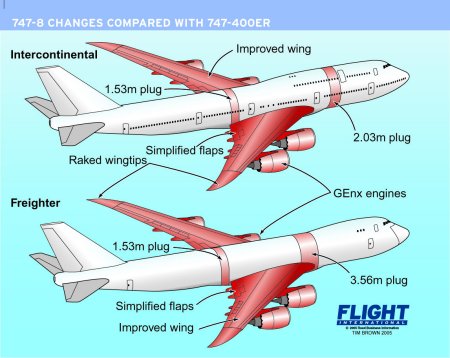The Boeing 747-8 will introduce an upgraded cockpit that borrows technology from the 777 and recently launched 787 programmes, but still shares a common pilot type-rating with the existing 747-400.

Boeing vice-president 747 programmes Jeff Peace says two to four days of differences training will be necessary for 747-400 pilots to use the new aircraft’s electronic checklists, cursor controls and upgraded flight management computer.
Peace says the -8’s “essentially new wing” will feature a simpler flap system with fewer parts, which should improve reliability. Double-slotted inboard and single-slotted outboard trailing-edge devices replace the 747’s current triple-slotted flaps, and raked wingtips have been added.
“We left the [wing] planform and the location of the structure the same,” says Peace, to allow existing production tooling to be used. The 68.5m-span wing will incorporate new materials and thicker gauges and has also been “retwisted and relofted”, says Peace. The aircraft will use a strengthened landing gear fitted with 777 tyres.
Overall, there will be 80% parts commonality with the 747-400 for maintenance purposes, Peace says.
To cut production costs, Boeing is trying to reduce the number of airline customisation options. This will, for example, mean that a satellite communications antenna will be fitted as standard and there will be a single wheel and brakes vendor, says Peace.
The 747-8’s 66,500lb-thrust (296kN) GEnx-2B67 engines will use the same core as the bleed-enabled version of the 787’s bleedless powerplant that is under development for the Airbus A350, but married to a smaller 2.64m-diameter (104in) fan to avoid having to introduce a taller landing gear.
The new engines help to reduce the 747-8’s 85dBA noise contour at maximum take-off weight by “more than 30%” compared with the 747-400.
The -8 Intercontinental passenger version will be equipped with the recontoured “Signature” cabin recently introduced on the 747-400ER.
Maximum take-off weight will be just under 436t (960,000lb), up from the 413t of the -400ER, and the operating empty weight of the passenger version is likely to come in at around 181t, although “we’re still working with aerodynamic trades”, says Peace.
The configuration of both -8 models is due to be frozen in the third quarter next year. High-speed windtunnel tests will be carried out early in 2006, followed by low-speed trials in May.
The first -8F is due to be rolled out in the third quarter of 2008 and fly by the end of that year, followed by entry into service in September 2009.
The service entry of the -8 Intercontinental is targeted for February 2010. Range of the passenger model is extended from the -400’s 13,690km (7,400nm) to 14,800km.
Boeing expects to certificate the aircraft under the US Federal Aviation Administration’s “changed product rule”; the manufacturer’s 747-400BCF converted freighter became the first major Boeing programme to undergo this amended certification process. n
Source: Flight International



















